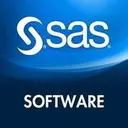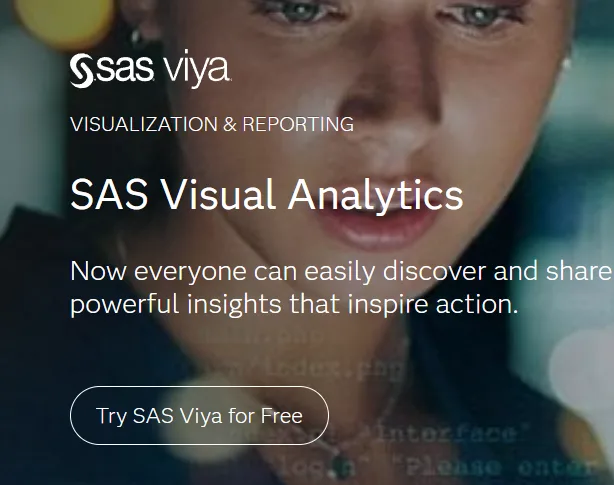In today’s vast ocean of data, where every drop holds the potential to guide strategic decisions, the choice of your analytics tool is your compass. Two notable vessels, SAS Visual Analytics and Zoho Analytics, offer to navigate through these waters, each promising to reveal insights hidden beneath waves of information. But which one will steer your business towards uncharted territories of success? Whether you’re diving into the depths of data for buried treasures or sailing across to understand the surface trends, this guide is your first mate in choosing the analytics tool that best fits your voyage.
| SAS Visual Analytics | Zoho Analytics |
|---|---|
 |  |
| G2 Score -4.4 out of 5 | G2 Score -4.3 out of 5 |
| TrustRadius Score -8.4 out of 10 | TrustRadius Score -8.1 out of 10 |
Area of Comparison: User Interface and Accessibility
The bridge of a ship, much like the user interface of an analytics tool, is where decisions are made. Ease of navigation and the accessibility of controls can determine how swiftly and effectively a crew can respond to the changing seas. Here’s how SAS Visual Analytics and Zoho Analytics fare in guiding users to their insights.
SAS Visual Analytics: The Commanding View
SAS Visual Analytics offers a robust and comprehensive view, designed for organizations that navigate through complex data seas. Its interface is powerful, catering to users who seek depth and control in their analytical explorations. With advanced customization options and a wide array of tools at your disposal, SAS Visual Analytics is like a well-equipped command center, ready for deep data dives.
The sophistication of SAS Visual Analytics comes with a learning curve, akin to mastering the controls of a sophisticated vessel. It requires time and dedication to navigate efficiently, but for those willing to learn, it unveils a world of insights, allowing for detailed analyses and tailored data explorations.
Zoho Analytics: The Agile Skipper
In contrast, Zoho Analytics prides itself on agility and ease of use, making it a favorite among businesses looking for quick insights without a steep learning curve. Its user interface is intuitive, inviting users of all skill levels to engage with their data confidently. With drag-and-drop functionalities and a straightforward dashboard setup, Zoho Analytics ensures that critical insights are just a few clicks away, making data analytics accessible to everyone on board.
This approachability does not mean Zoho Analytics lacks power. On the contrary, it offers a range of analytical capabilities and visualization options, all within a framework that emphasizes user experience and quick learning.
Pricing Structure: SAS Visual Analytics vs Zoho Analytics
Understanding how each platform positions itself in the market from a financial perspective is crucial. The right choice balances the tool’s value with the investment required, ensuring organizations can access powerful analytics capabilities without straining their budgets. Here’s how SAS Visual Analytics and Zoho Analytics stack up when it comes to pricing.
SAS Visual Analytics: The Enterprise Navigator

SAS Visual Analytics is part of the broader SAS suite, known for its robust, enterprise-level analytics solutions. Pricing for SAS products, including Visual Analytics, typically reflects their positioning as premium offerings. While specific pricing details are often customized based on the client’s needs, scale of deployment, and the breadth of functionalities required, it’s widely acknowledged that SAS targets larger organizations and enterprises with its pricing model.
Organizations interested in SAS Visual Analytics should be prepared for an initial investment that includes licensing fees and possibly ongoing costs for support and updates. The platform’s comprehensive analytics capabilities, coupled with SAS’s reputation for industry-leading data science tools, justify its premium pricing for many businesses, especially those with extensive, complex data analytics needs.
Zoho Analytics: The Accessible Analyst

Zoho Analytics presents itself as a more accessible solution, with clear, transparent pricing tiers listed on its website. This platform caters to a wide range of users, from small businesses to larger enterprises, with a pricing structure designed to scale with the organization’s size and usage. Zoho offers a free tier for individuals or small teams just starting with analytics, and its premium plans are structured based on features, the number of users, and data rows or records.
This transparent and scalable pricing makes Zoho Analytics an attractive option for businesses seeking powerful analytics capabilities without a significant upfront investment. The platform’s value proposition is particularly appealing to small and medium-sized businesses or departments within larger organizations looking to deploy specific analytics projects.
Data Integration Capabilities: SAS Visual Analytics vs Zoho Analytics
The ease with which an analytics tool can harmonize data from varied sources is akin to a ship’s ability to navigate through treacherous waters, bringing together all navigational inputs to chart a clear course. Here’s how these two platforms manage the crucial task of integrating data from various origins, enabling organizations to gain a comprehensive view of their informational landscape.
SAS Visual Analytics: The Seasoned Mariner
SAS Visual Analytics, with its long-standing legacy in the analytics realm, offers robust data integration capabilities. It’s designed to seamlessly bring together data from a multitude of sources, whether they’re on-premises databases, cloud storage solutions, or even unstructured data formats. Its powerful ETL (Extract, Transform, Load) functionalities ensure that data is not just aggregated but also cleansed and transformed, ready for in-depth analysis.
This platform is like a seasoned mariner, skilled in navigating the complexities of data seas, making it an excellent choice for large enterprises or organizations with diverse data ecosystems. The ability to handle massive volumes of data from various sources makes SAS Visual Analytics a formidable tool for businesses that require a holistic view of their data landscape.
Zoho Analytics: The Agile Voyager
On the other side, Zoho Analytics specializes in offering a streamlined and efficient approach to data integration. It provides a wide array of connectors to popular business applications, cloud services, and databases, enabling users to easily pull data from these sources into the platform. Zoho Analytics focuses on simplifying the data integration process, making it accessible even to those with limited technical expertise.
Its agility as a voyager, quickly adapting to various data sources and providing users with the tools to integrate them effortlessly, makes Zoho Analytics particularly appealing to small and medium-sized businesses. This platform ensures that organizations can start analyzing their data swiftly, without getting bogged down by complex integration processes.

Related: Check out our free SEO suite

Customer Support and Community Engagement: SAS Visual Analytics vs Zoho Analytics
The level and quality of support provided by an analytics platform can greatly influence user satisfaction and the overall effectiveness of the tool within an organization. Likewise, a vibrant user community can offer invaluable resources, from troubleshooting help to innovative usage ideas. Here’s how SAS Visual Analytics and Zoho Analytics compare in these crucial areas.
SAS Visual Analytics: The Established Support Network
SAS Visual Analytics benefits from SAS’s long history and established presence in the analytics field, providing users with a comprehensive support system. This includes dedicated technical support, extensive documentation, and a wealth of online resources. SAS also offers tailored support services, training programs, and consulting to help organizations maximize their use of SAS Visual Analytics.
Furthermore, SAS boasts a vast user community, including forums, user groups, and social media channels, where users can exchange knowledge, learn from each other’s experiences, and stay updated on the latest developments. This extensive network is a testament to SAS’s commitment to supporting its users, from solving technical issues to helping businesses achieve their analytical goals.
Zoho Analytics: The Agile and Responsive Community
Zoho Analytics, while newer to the analytics scene compared to SAS, has quickly established a reputation for providing agile and responsive customer support. Zoho offers a range of support options, including email, live chat, and phone support, ensuring that users can get help when they need it. The platform also features a comprehensive knowledge base, with articles, how-to guides, and video tutorials designed to help users navigate and utilize Zoho Analytics effectively.
The Zoho Analytics user community is active and growing, with forums and user groups where individuals can ask questions, share insights, and learn from the experiences of others. Zoho’s approach to community engagement, focusing on accessibility and responsiveness, reflects its broader mission to make analytics accessible to businesses of all sizes.
Scalability and Performance: SAS Visual Analytics vs Zoho Analytics
This facet is vital as it determines how well an analytics platform can grow with your organization, adapting to increasing data volumes, more complex analytics requirements, and a growing user base without compromising on performance or user experience.
SAS Visual Analytics: Built for Growth
SAS Visual Analytics is engineered with enterprise scalability in mind, designed to handle vast amounts of data and a large number of concurrent users efficiently. Its architecture supports high-performance analytics, allowing businesses to scale their data exploration efforts as they grow. This capability is backed by SAS’s powerful servers and cloud infrastructure, which ensure that the system remains responsive and reliable, even as the complexity and volume of data increase.
For organizations with ambitious growth plans or those already operating at a large scale, SAS Visual Analytics provides a solid foundation that can support expanding data analytics needs. This makes it an ideal choice for large enterprises or rapidly growing businesses seeking a platform that can keep pace with their development.
Zoho Analytics: Agile and Adaptable
Zoho Analytics offers a different approach to scalability, focusing on flexibility and adaptability. It caters well to small and medium-sized businesses with its cloud-based platform, ensuring that these organizations can start small and scale up their analytics efforts as needed. Zoho Analytics allows for easy scaling in terms of data volume and the number of users, with various subscription plans that can be adjusted to match the organization’s growth.
While Zoho Analytics may not match the raw performance capabilities of SAS Visual Analytics, especially at the enterprise level, it provides sufficient power for many businesses’ analytics needs. Its agility and ease of scaling make it a compelling choice for SMEs or departments within larger organizations looking for a scalable analytics solution that offers good performance without requiring significant IT infrastructure investments.
Conclusion
As we draw our analytical voyage between SAS Visual Analytics and Zoho Analytics to a close, we’ve navigated through the critical considerations that organizations face when selecting an analytics platform. From the depths of data integration capabilities to the vast horizons of user interface and accessibility, advanced analytics, pricing, customer support, community engagement, and scalability, our journey has provided a comprehensive map to guide your decision-making process.
Thank you for embarking on this detailed exploration of SAS Visual Analytics and Zoho Analytics. As you stand at the helm, ready to steer your organization through the data-driven waters ahead, remember that the best analytics tool is the one that aligns with your journey’s objectives, empowers your team, and navigates seamlessly towards your strategic destinations.
READ NEXT:
- SAS Visual Analytics vs Tableau: The Best Analytics Tool for You
- SugarCRM vs Vtiger: The Best CRM Tool for You
- QlikView vs Kissmetrics: The Best Analytics Tool for You
- What are the types of Share Capital a Company in India can have?
- SAS Visual Analytics vs Woopra: The Best Analytics Tool for You
- 11 Marketing Analytics Tools to Elevate Your Data-Driven Strategies
- 29+ Digital Analytics Software to Skyrocket Your Digital ROI






















Comments are closed.